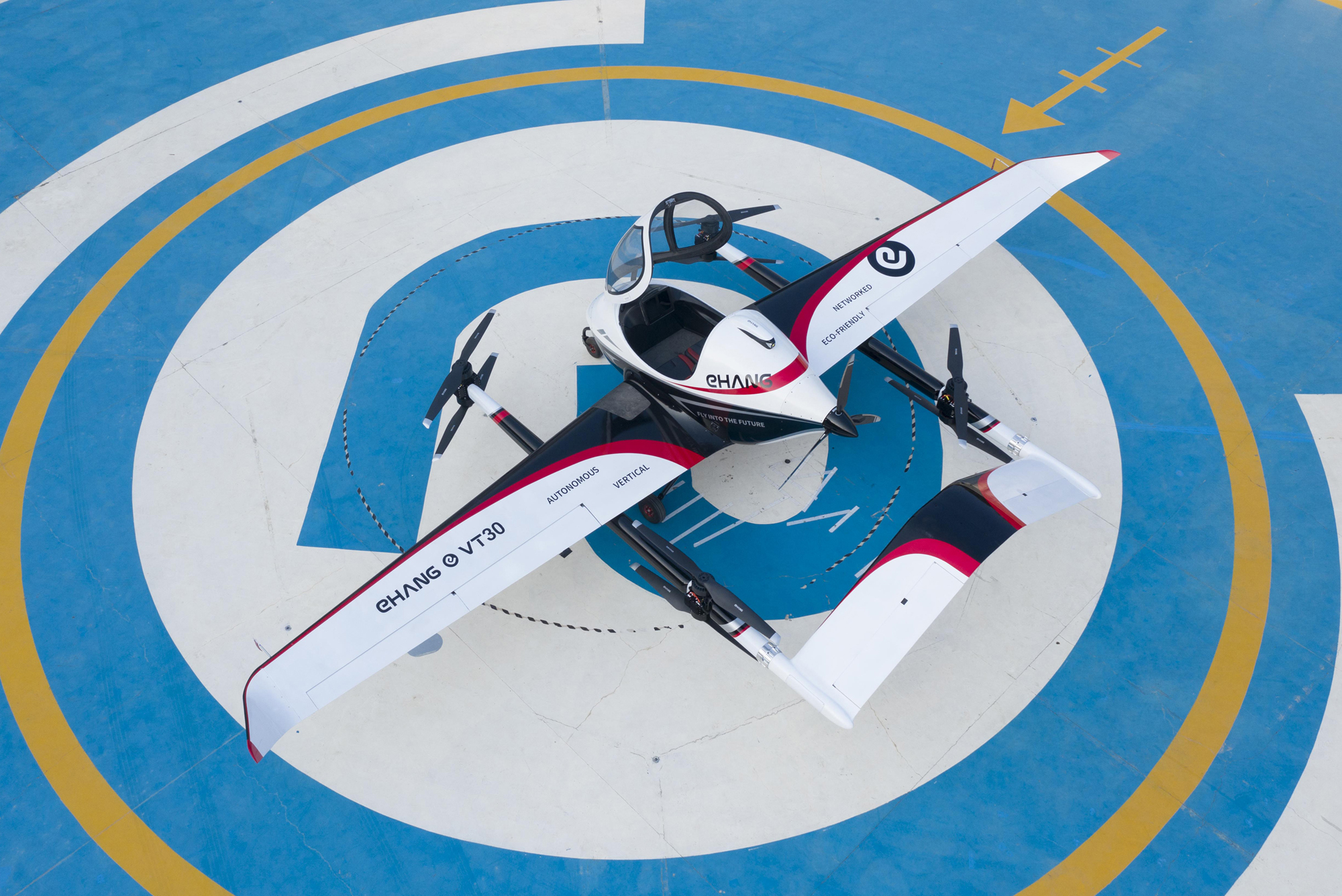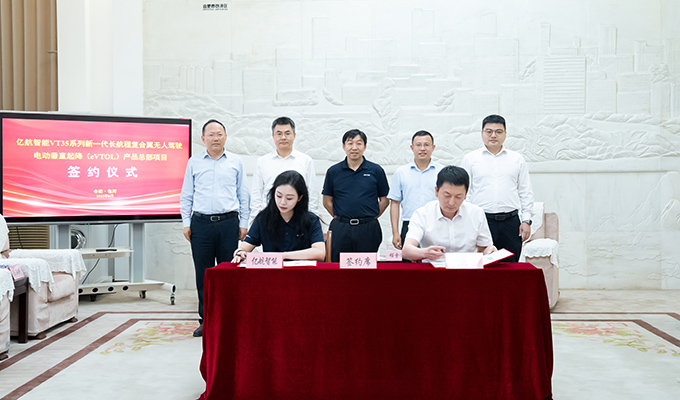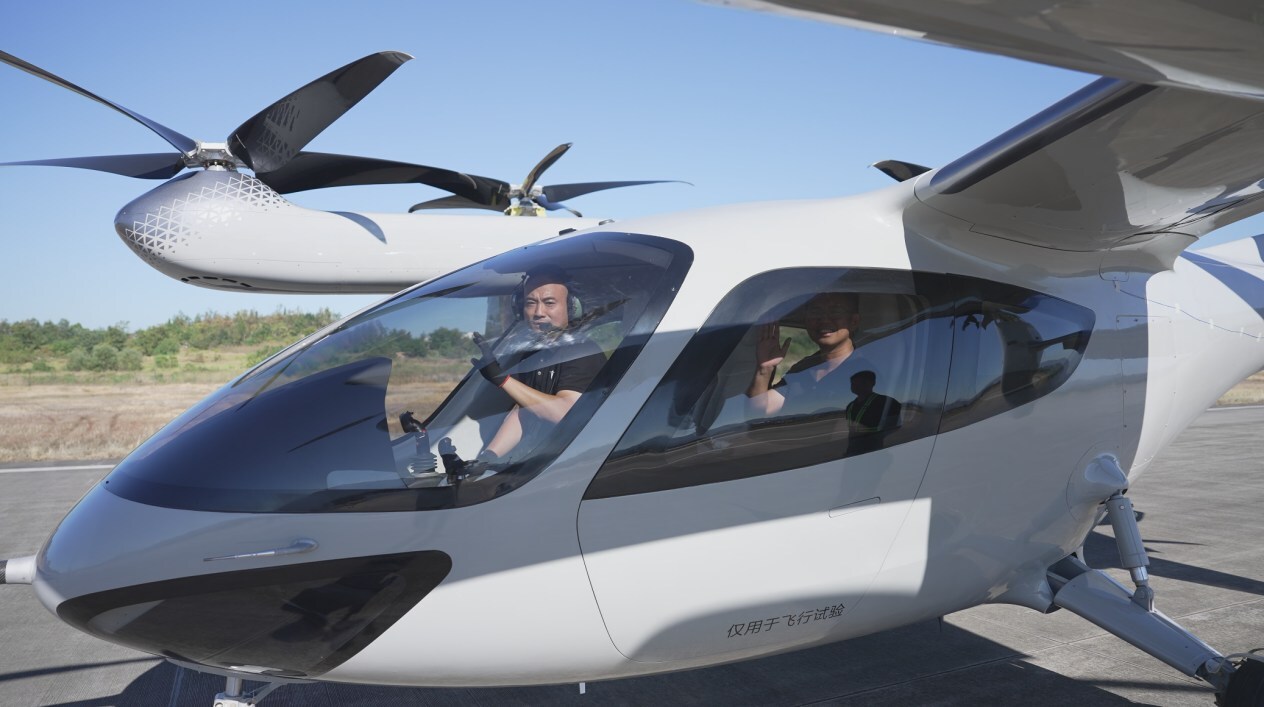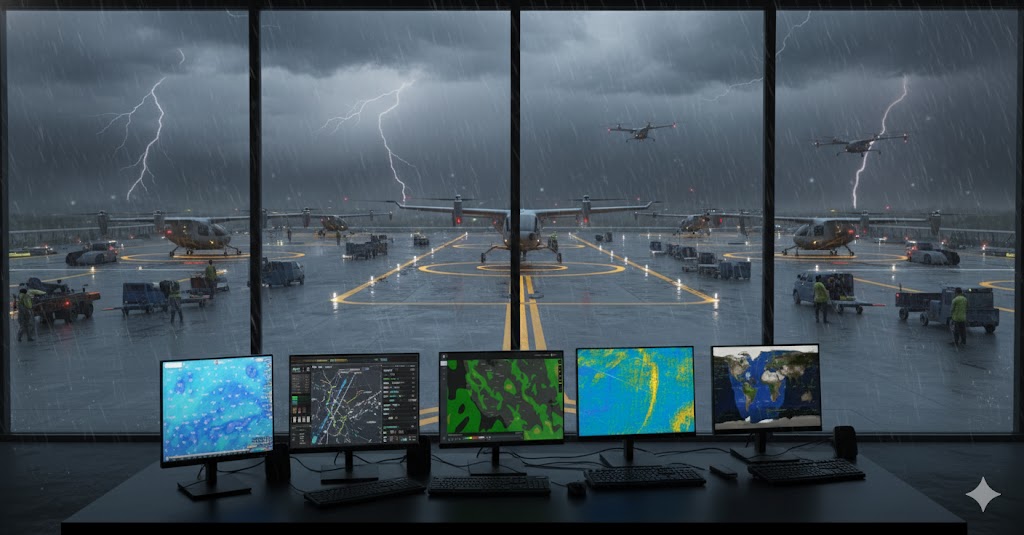China just took a step forward in the future of flight. EHang Holdings, the Guangzhou company that’s been making autonomous aircraft while competitors argue about pilot requirements, signed a partnership with Hefei’s government that brings 1.5 billion RMB to the table and creates an entire ecosystem for their next-generation VT35 aircraft.
The deal breaks down like this: EHang invests 1 billion RMB to build a comprehensive hub covering research, development, testing, manufacturing, certification, supply chain management, sales, operations, and talent development. Hefei’s government adds another 500 million RMB through aircraft orders and industrial cooperation. But this isn’t just about building another factory. They’re creating a complete vertical integration play for bringing long-range electric aircraft to market.
The partnership builds on EHang’s existing East China Regional Headquarters in Hefei, where the company already operates. But the new commitment represents what EHang calls “a significant upgrade” that will accelerate VT35 industrialization. The aircraft itself completed final assembly and began full-scale flight testing, with EHang planning to unveil the VT35 in the third quarter of 2025.
The VT35: EHang’s Long-Range Bet
The VT35 represents EHang’s move beyond short urban hops into medium and long-distance air mobility. While their certified EH216-S handles routes up to 35 kilometers, the VT35 targets intercity, cross-sea, and cross-mountain transport. The aircraft builds on their earlier VT30 prototype but includes major upgrades to autonomous flight control and propulsion systems.
What makes the VT35 different is its lift-and-cruise design philosophy. Instead of the EH216-S’s multicopter configuration with 16 propellers, the VT35 uses separate systems for vertical takeoff and efficient forward flight. This hybrid approach trades mechanical complexity for much better energy efficiency during cruise operations, enabling the longer ranges that make intercity transport viable.
The aircraft maintains EHang’s commitment to fully autonomous operation, with no onboard pilot required. Ground-based command and control systems manage multiple aircraft simultaneously, reducing operational costs compared to piloted alternatives. EHang’s proprietary autonomous flight technology delivers what the company describes as “breakthrough improvements in both design and reliability” compared to earlier aircraft.
While specific payload figures haven’t been officially disclosed for the VT35, industry sources suggest a capacity of 450 kilograms, accommodating four to five passengers or equivalent cargo. The VT30 prototype, which the VT35 builds upon, was designed for two passengers with a 300-kilometer range and up to 100 minutes of flight time. The VT35 appears to maintain similar range capabilities while adding enhanced performance characteristics.
 The VT30 prototype, which the VT35 builds upon
The VT30 prototype, which the VT35 builds upon
EHang submitted their Type Certificate application to China’s Civil Aviation Administration (CAAC) in February 2025, and the review process continues. The company plans to pursue not just Type Certification but also Production Certificate and Standard Airworthiness Certificate, all from their new Hefei facility. They’ll also help their joint venture, Hefei Heyi Aviation, apply for Air Operator Certification specifically for VT35 operations.
Hefei: China’s Strategic Aviation Hub
 EHang and Hefei government sign agreement to establish VT35 long-range eVTOL headquarters in Hefei
EHang and Hefei government sign agreement to establish VT35 long-range eVTOL headquarters in Hefei
Hefei’s selection for this partnership wasn’t random. The city of 4.83 million people in the metropolitan area (with administrative boundaries reaching 10.002 million permanent residents as of 2024) has become one of China’s most important technology centers. Located in central Anhui Province, Hefei sits within a 500-kilometer radius covering seven provinces and encompassing 500 million people who generate 47% of China’s GDP.
The city’s economic growth tells the story of its appeal. Hefei’s population increased by 2.3 percent in 2023, driven primarily by the migration of skilled workers. Over 350,000 newly insured college graduates entered employment in the city, reflecting its magnet effect for young talent. By 2024, Hefei became China’s 18th city to exceed 10 million permanent residents in its administrative area.
What makes Hefei particularly valuable for advanced manufacturing is its combination of technical talent, supportive government policies, and established supply chains. The city hosts major universities, including the University of Science and Technology of China, consistently ranked among the world’s top 100 research institutions. The presence of 13 institutions of higher learning and over 200 scientific institutions creates a talent pool of around 170,000 specialized technical workers.
Hefei already serves as a manufacturing center for companies like JAC Motors, with whom EHang established a joint venture. This partnership leverages automotive manufacturing expertise to benefit aircraft production. Local government backing is strong, demonstrated by their commitment of over 500 million RMB and guaranteed aircraft orders to aid EHang's growth.
 Hefei: China's Low-Altitude Economy Development Hub
Hefei: China's Low-Altitude Economy Development Hub
The city’s designation as a comprehensive national science center and strategic node in China’s Belt and Road Initiative provides additional advantages. Local authorities actively support technology companies through policy frameworks designed to encourage innovation and industrial development.
Competition in the Long-Range eVTOL Market
The VT35 enters a crowded but underdeveloped market for long-range electric aircraft. Most eVTOL competitors focus on short urban routes, but several companies are pursuing similar intercity capabilities.
Joby Aviation leads the American effort with its S4 aircraft, designed for a 241-kilometer range at speeds up to 322 kilometers per hour. Joby’s aircraft carries four passengers plus a pilot and uses six electric motors in a tilting configuration. The company has taken a vertically integrated approach, developing most components in-house, which provides better performance control but requires higher capital investment.
Archer Aviation offers the Midnight eVTOL with a similar passenger capacity but shorter range at 96 kilometers. Archer chose a different strategy, working with established aerospace suppliers to accelerate certification and reduce development costs. Their aircraft uses eight motors with two different designs, potentially complicating maintenance compared to more standardized approaches.
Lilium from Germany takes the most distinctive approach with its seven-seat aircraft powered by 36 electric ducted fans. The company claims a 250-kilometer range and emphasizes lower noise levels through its ducted fan design. Lilium’s larger capacity could provide better unit economics, but its complex propulsion system faces significant certification challenges.
AutoFlight’s Prosperity I can carry three passengers plus cargo over distances up to 250 kilometers. The company has focused heavily on international markets, conducting test flights across Europe, North America, and Asia. Their aircraft uses conventional runways for takeoff and landing, which limits operational flexibility but simplifies certification requirements.
The VT35’s competitive advantages become clear when examining these alternatives. Its 300-kilometer range matches or exceeds most Western competitors while targeting similar market segments. The autonomous operation eliminates pilot costs and complexity, potentially reducing operating expenses by 30-40% compared to piloted alternatives. EHang’s early regulatory success in China, including the world’s first eVTOL type certificate and air operator certificate, provides a substantial head start over competitors still navigating certification processes.
However, the VT35 also faces challenges. Its autonomous operation may encounter regulatory resistance in markets outside China, where authorities prefer human pilots as backup systems. The aircraft’s lift-and-cruise design requires proving reliability across multiple flight phases, potentially complicating certification compared to simpler multicopter configurations.
Building the Low-Altitude Economy
The Hefei partnership represents more than manufacturing expansion. It’s part of China’s broader push to create what officials call the “low-altitude economy,” encompassing all aviation operations below 3,000 meters altitude. This includes passenger air taxis, cargo drones, agricultural applications, emergency services, and tourism flights.
Chinese government projections suggest the low-altitude economy could reach 2 trillion yuan in annual value by 2030. That’s roughly $280 billion, larger than many countries’ entire GDP. EHang positions itself to capture significant market share by establishing integrated operations that handle everything from aircraft design to flight services.
The VT35’s more extended range capabilities make it particularly valuable for connecting China’s numerous medium-sized cities that lack convenient transportation links. High-speed rail serves major routes effectively, but hundreds of city pairs still require long bus rides or multiple flight connections through major airports. Electric aircraft could provide direct point-to-point connections that bypass traditional aviation infrastructure.
EHang’s approach addresses one of the low-altitude economy’s most significant challenges: achieving sufficient operational scale for cost competitiveness. By concentrating design, manufacturing, certification, and operations in one location, the company can iterate faster and reduce the complexity of managing multiple suppliers and partners.
The Hefei facility targets production of 1,000 aircraft annually by the end of 2025, according to EHang’s previous capacity expansion announcements. That would represent a massive scale-up from current production levels and position the company to serve both domestic and international markets as regulatory approvals expand.
This policy environment creates significant advantages for Chinese eVTOL companies compared to international competitors. While Western markets debate regulatory frameworks and conduct limited trials, China actively builds infrastructure and operational ecosystems for low-altitude aviation.
Certification Timeline and Market Timing
EHang’s VT35 certification timeline reflects faster regulatory progress than most global eVTOL programs. CAAC accepted the Type Certificate application in February 2025, with the aircraft currently under airworthiness review. This timeline positions EHang ahead of most Western competitors, facing longer certification processes and more conservative regulatory approaches.
The regulatory pathway builds on EHang’s proven track record. Their EH216-S received the world’s first eVTOL type certificate and has accumulated over 66,000 safe flights across 19 countries with zero accidents. In March 2025, EHang received the world’s first Air Operator Certificate for autonomous eVTOL operations, allowing limited commercial passenger operations in China.
EHang’s plans extend beyond basic type certification. The company will pursue Production Certificate and Standard Airworthiness Certificate for the VT35, while helping their joint venture apply for Air Operator Certification. This comprehensive approach enables the full range of commercial operations, including urban and intercity passenger transport, logistics, and emergency rescue services.
The certification work concentrated in Hefei provides operational advantages. By conducting all regulatory activities in one location with strong government support, EHang can coordinate more effectively with CAAC and accelerate the approval process. Local authorities understand the economic value of supporting certification success and can provide resources and expertise to address regulatory requirements.
Economic Implications and Future Prospects
The urban air mobility market represents a potentially massive economic opportunity. Conservative estimates suggest the global market could reach $1.5 trillion as the industry matures. EHang’s positioning in the Chinese market, combined with early regulatory approval, positions the company to capture significant value in this emerging industry.
The Hefei partnership’s economy deserves attention. EHang’s joint venture with JAC Motors and local suppliers could reduce manufacturing costs by 30-40% compared to Western alternatives. This cost advantage, combined with autonomous operation eliminating pilot expenses, positions EHang’s services to compete effectively on price.
Government orders included in the Hefei support package provide revenue visibility and reduce market risk during early commercialization phases. These guaranteed purchases allow EHang to scale production and refine operations before expanding to purely commercial markets.
The VT35’s focus on intercity transport addresses a different market segment than most competitors targeting urban shuttle services. Intercity routes of 100-300 kilometers represent sweet spots where eVTOLs can offer significant time savings over ground transportation while remaining cost-competitive with conventional aviation.
For passengers, the VT35’s success could mean access to transportation options that don’t exist today. Flying directly from downtown Hefei to central Nanjing in 90 minutes, without airports, security lines, or ground transportation at either end, and connecting coastal cities to island destinations that currently require long ferry rides or expensive helicopter charters.
The broader implications extend beyond passenger transport. The VT35’s payload capacity makes it suitable for cargo operations, emergency medical transport, and logistics applications in areas where ground transportation faces geographic or infrastructure limitations. China’s vast territory includes numerous regions where aircraft operations could provide connectivity that road or rail construction cannot economically achieve.
EHang’s partnership with Hefei represents a bet that the low-altitude economy will develop faster in China than elsewhere, and that early market leadership will create sustainable competitive advantages. The company has already proven this thesis with their EH216-S operations, becoming the first worldwide to achieve commercial passenger flights with autonomous eVTOLs.
Whether this success scales to longer-range operations remains to be seen. The VT35 faces more complex certification requirements, higher operational costs, and competition from both aviation and ground transportation alternatives. But EHang’s track record suggests they understand how to navigate Chinese regulatory systems and build profitable operations around autonomous aircraft technology.
The next few years will determine whether Hefei becomes the center of a new aviation industry or just another ambitious development project. With 1.5 billion yuan backing the effort and a proven aircraft company leading the charge, the future of flight might launch from a city that most people would need to look up on a map.





